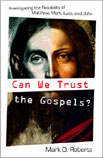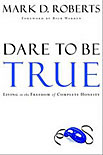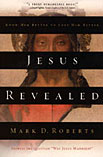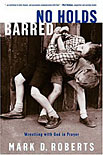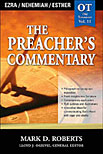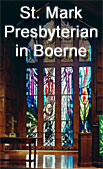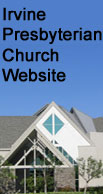My blog has moved! http://www.patheos.com/blogs/markdroberts/
|
 |
Twitter Feed for My Recent Blog Posts and Other Tweets |
My blog has moved! http://www.patheos.com/blogs/markdroberts/
|
Sunday Inspiration from The High Calling
By Mark D. Roberts | Sunday, January 20, 2008
“Hint of the Savior”
“And I will cause hostility between you and the woman, and between your offspring and her offspring. He will strike your head, and you will strike his heel.”
Throughout the ages, Christian commentators have seen in Genesis 3:15 the first hint of the Savior. There will be hostility between the serpent (an image of Satan) and the offspring of the woman (literally her “seed”). One born of a woman will one day strike the serpent’s head, killing it.
Calling Genesis 3:15 a prophecy might be a bit excessive. But, as we read from a Christian perspective, we see in God’s words to the serpent the first hints of the Savior yet to come.
Do you believe that your life is touched by evil forces beyond the natural ones? What difference does this make in how you live?
PRAYER: O Lord, we feel the “bite of the serpent” in our lives as we are tempted, as we give way to sin. We sense the hostility spoken of in this text, and we hate it.
Thank you, gracious God, for seeing even from the beginning that from the woman’s offspring would come the one to crush the head of the serpent. Thank You for Jesus, our Savior, whose death broke the power of evil and set us free from the stain of sin. Amen.
Note
This Daily Reflection is from The High Calling of Our Daily Work website. Each day I publish a reflection/devotional on The High Calling. From this website you can sign up to receive the Daily Reflection in your e-mail box.
Extra

I am reminded of one of the most brilliant scenes in Mel Gibson’s film The Passion of the Christ. As Jesus is praying in the Garden of Gethsemane, Satan comes to tempt him. As the temptation continues, a white snake moves from Satan in the direction of Jesus. In a moment of sheer determination, Jesus crushes the head of the snake, and then Satan disappears.

Topics: Sunday Inspiration | No Comments »
Poltergeist at Night
By Mark D. Roberts | Saturday, January 19, 2008

Poltergeist is a roller coaster at Six Flags Fiesta Texas in San Antonio. I’ve been on faster thrill rides, but I don’t think I’ve ever been on one that was more compact. There are almost no straight sections of Poltergeist, only curves, dips, turns, flips, and cork screws. I give Poltergeist an 8 out 10 on the Mark scale of roller coasters.
If you’d like to ride Poltergeist but can’t make it to Texas, check out this YouTube video (not mine).
Topics: Only in Texas | No Comments »
A Review of God at Work: The History and Promise of the Faith at Work Movement by David W. Miller (Section 4)
By Mark D. Roberts | Friday, January 18, 2008
In the series: God at Work: A Review of the Book by David Miller
Permalink for this post / Permalink for this series
Yesterday I began examining David Miller’s recommendations for clergy in his fine book, God at Work.
Here is Miller’s second recommendation for clergy:
Clergy who wish to equip their people to integrate faith and work will also need to develop a ministry of public preaching and prayer that intentionally and constructively addresses all dimensions of the Four E’s of ethics, evangelism, experience, and enrichment. Sermons and pastoral prayers play a vital theological role as part of a ministry of integration to those in the business world, helping people to discover their vocational identity, resist splitting the sacred from the secular, navigate difficult ethical questions, and gain comfort for personal needs and hurts. (p. 147)
Again, I agree with Miller, though I wouldn’t put it quite that way. It’s not so much that clergy need to “develop a ministry” as that they need to include within their ministry of preaching and prayer the issues that Miller raises. We’re not talking about starting new ministries here so much as about adapting and expanding existing ministries. If preachers and prayers began to think about the implications of their content for the workplace, then they’d find it natural to preach and pray about faith in this context.
Miller suggests three other ministries that clergy need to develop:
a ministry of teaching that includes all dimensions of the Four E’s (p. 147);
a ministry of spiritual integration that ensures that laity are trained to utilize personal prayer and devotional study in their daily lives (p. 148);
a ministry of gatherings for businesspeople to help address the Four E’s (p. 148).
Again, I agree with the substance of Miller’s suggestions. I’d only quibble about the language. Clergy don’t so much need to develop new ministries as they do to expand and enrich their existing ministries.
In fact, most pastors I know are deeply committed to helping their people live out their faith in the world. If they would only follow the first of Miller’s suggestions by visiting people in their workplaces and by listening to people talk about their work, then most pastors would more or less automatically begin to incorporate FAW emphases in their existing ministries.
I actually believe that lay people could do a great deal to advance this agenda. If they want to have their pastors equip them for their ministries in the workplace, then they need to say so. Part of what helped me to do this very thing was when people in my congregation would meet with me to share their challenges at work. I couldn’t help but become aware of this cutting edge of their discipleship. And, therefore, it wasn’t hard for me to incorporate such concerns in my preaching and praying. Of course I realize some pastors are not responsive to the needs of their people, and others might be threatened by workplace ministry because they feel inadequate to address it. But I think the strong majority of pastors would work hard to speak to the needs of their people. (Photo: The lay people of Irvine Presbyterian Church on my last Sunday.)

It may be, however, that many (most?) working people wouldn’t think to ask their pastors for help because they tend not to integrate their faith with their work. Hence we might find ourselves in a no-win cycle, in which pastors don’t help lay people to realize that their faith should be expressed in their workplaces and lay people don’t ask pastors for help because they don’t think to do it. Mutual inattention encourages more mutual inattention.
Yet there is plenty of hope, I think, in that it doesn’t take a majority of a congregation to influence a pastor, or a year’s worth of preaching on FAW for a pastor to influence a congregation. Even one or two lay people who are willing to share their challenges and concerns with a pastor can make a tangible difference. And if a pastor begins on a fairly regular basis to speak of workplace discipleship, this can also make a tangible difference.
What’s the one major thing I would do differently if I were a pastor again? Actually, it wouldn’t be in the areas of preaching and prayer. Rather, I’d make a stronger effort to encourage lay people to tell their own stories: in worship services, in classes, in church publications, etc. The power of a lay witness cannot be understated here. If a teacher shares with others how he tries to live out his faith in the classroom, if a lawyer shares her struggles and victories with others, and so on throughout the professions, this would have a huge impact on the church, clergy and laity alike.
Topics: God at Work | 4 Comments »
A Review of God at Work: The History and Promise of the Faith at Work Movement, by David W. Miller (Section 3)
By Mark D. Roberts | Thursday, January 17, 2008
In the series: God at Work: A Review of the Book by David Miller
Permalink for this post / Permalink for this series
So far in this series I’ve examined some of the main ideas in God at Work by David Miller. In my last post I focused on Miller’s criticism of the church’s failure to help working people see their workplace as a context of ministry. In this post I want to explore Miller’s recommendations for the church and the theological academy.
These recommendations are found in Chapter 8 of God at Work: “The Future of the Faith at Work Movement.” Miller believes that change needs to happen if FAW is to thrive, with the end of church and social transformation. His proposals begin this way:
A logical starting place for change is the place where clergy are trained. Seminaries and divinity schools should recognize anew the theological, practical, and pastoral importance of the workplace with a view toward training pastors to minister more intentionally and effectively to their parishioners in the business world and other workplaces. (p. 144)
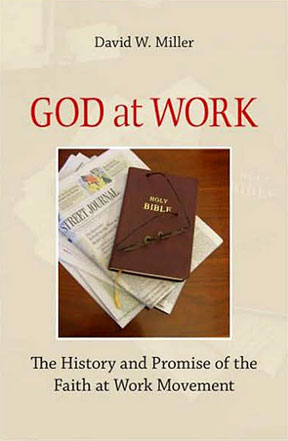 This will be especially challenging, Miller notes, for seminary professors who, especially in mainline seminaries and divinity schools, almost always assume that capitalism is necessarily evil. One practical suggestion Miller makes is for seminaries and denominations to “expand the conception of clinical pastoral education (CPE) and field education programs from the traditional realms of hospitals, prisons, and psychiatric wards to include internships in local businesses and workplaces” (p. 144). This is a phenomenal idea, in my opinion. But I can only imagine the responses of many who have vested interest in the status quo of CPE and internships, and who couldn’t imagine pastoral training happening in the context of what they would think of as godless capitalism.
This will be especially challenging, Miller notes, for seminary professors who, especially in mainline seminaries and divinity schools, almost always assume that capitalism is necessarily evil. One practical suggestion Miller makes is for seminaries and denominations to “expand the conception of clinical pastoral education (CPE) and field education programs from the traditional realms of hospitals, prisons, and psychiatric wards to include internships in local businesses and workplaces” (p. 144). This is a phenomenal idea, in my opinion. But I can only imagine the responses of many who have vested interest in the status quo of CPE and internships, and who couldn’t imagine pastoral training happening in the context of what they would think of as godless capitalism.
Though Miller has more suggestions for theological academies, he offers several challenges for churches and clergy as well:
Pastors and churches that wish to respond seriously to the Sunday-Monday gap will need to develop new strategies of equipping laity for a ministry of integration that connects the Christian faith to the workplace in meaningful and constructive ways. (p. 146).
Miller believes that the church has strong potential to make a difference in this regard. But it requires more than just the addition of a special class or sermon series. According to Miller, “this attitude needs to be evident in all dimensions of ministry” (p. 146).
Clergy bear a significant burden in Miller’s envisioned future of FAW. He recommends, for example:
Clergy who wish to equip their people to integrate faith and work effectively will first need to develop a ministry of presence and listening in the work sphere. Clergy should go to their parishioners’ places of work for short visits as regularly and naturally as they make hospital and home visits. (p. 146).
I agree with Miller on this score. In fact, I expect that I spent more time with people in their places of work than I did in the hospital, partly because I had other pastors who did the lion’s share of hospital visitation. I loved to see where my church members worked. One highlight of my ministry at Irvine Presbyterian Church was visiting a church member who happened to be our congressman in his place of work. But, throughout the years, I visited schools, law firms, accountants offices, building sites, and dozens of other kinds of workplaces. (When I was an associate pastor in Hollywood, I once visited the workplace of a Hollywood set designer, and got to stand on the stage while they were filming part of the Brady Bunch Christmas Special. Think of that!)
Topics: God at Work | 2 Comments »
A Review of God at Work: The History and Promise of the Faith at Work Movement by David W. Miller (Section 2)
By Mark D. Roberts | Wednesday, January 16, 2008
In the series: God at Work: A Review of the Book by David Miller
Permalink for this post / Permalink for this series
Yesterday I began a review of God at Work: The History and Promise of the Faith at Work Movement, by David W. Miller. I explained that Miller’s book is an historical analysis of the Faith at Work (FAW) movement, which began with the social gospel movement of the late 19th and early 20th centuries. The second wave of FAW started after World War II and lasted into the 1980s. It majored in the ministry of the laity in the world, but ultimately petered out for a variety of reasons, including the redirecting of lay efforts from the world to the church. Today I’ll continue where I left off yesterday.
Miller identifies the third wave of FAW as “The Faith at Work Era (c. 1985-Present)” (pp. 63-78). This wave had, and continues to have, a particular focus on personal integration. As Miller comments,
People in the workplace of all levels and types no longer seem willing to leave their soul with the car in the parking lot. . . . Christian businesspeople and other professionals find common agreement that living a bifurcated life, where faith and work are compartmentalized, is neither true to the Gospel nor a healthy way to work. (p. 74)
At this point in the book Miller sets forth a way to understand FAW efforts in terms of four different emphases: ethics, evangelism, experience, and enrichment (pp. 76-78). Ministries with an ethical emphasis deal primarily with questions of right and wrong, including issues of justice, in the workplace. Evangelical ministries see the workplace primarily as a context for evangelism. Experiential efforts focus on meaning and purpose, with work as a context for experiencing God finding deeper purpose in life. Enrichment has to do with “spiritual disciplines, therapeutic healing, and transformation. For instance, many express renewed interest in spiritual nurturing and growth” (p. 77). I find Miller’s “Four E’s” helpful, though the distinction between Experience and Enrichment is sometimes elusive.
Chapter 5 of God at Work is, for me, the most discouraging chapter of the book. It is entitled “Response of the Church and the Theological Academy to FAW” (pp. 79-103). Miller shows how the church and the seminaries have, for the most part, ignored FAW. For example, for a while certain denominations and individual churches took on FAW concerns, but budget cuts and institutional pressures led to greater focus on internal matters and less attention to equipping lay ministers for their work in the world. Individual churches followed suit. One of the saddest quotations in God at Work comes from Bill Diehl, a one-time executive with Bethlehem Steel and one of the leaders of wave three in FAW. Diehl writes:
In the almost 30 years of my professional career, my church has never once suggested that there by any type of accounting of my on-the-job ministry others. My church has never offered to improve those skills which could make me a better minister, nor has it ever asked if I needed any kind of support in what I was doing. There has never been an inquiry into the types of ethical decisions I must face, or whether I seek to communicate the faith to my co-workers. I have never been in a congregation where there was any type of public affirmation of a ministry in my career [as a sales manager]. In short, I must conclude that my church really doesn’t have the least interest in whether or how I ministry in my daily work. (p. 82)
 As you might expect, Diehl’s indictment of his church led me to consider our efforts at Irvine Presbyterian Church during the sixteen years when I was the Senior Pastor there. I think we did some thing right. My preaching regularly mentioned the workplace as a context for living out faith. Sometimes I addressed issues that were of particular relevance to working people (such as my sermon series on truth that was the basis for my book, Dare to Be True). In worship we regularly prayed for people in certain vocations. As a pastor I often met with people to talk and pray about challenges at work. And I know that workplace issues were often the focus of small group discussion and prayer. During my weekly prayer meetings with my elders, for example, we prayed for work-related concerns almost every week. This alone would add up to more than a thousand work-focused prayers during my pastoral tenure. (Photo: Bill Diehl’s book, The Monday Connection.)
As you might expect, Diehl’s indictment of his church led me to consider our efforts at Irvine Presbyterian Church during the sixteen years when I was the Senior Pastor there. I think we did some thing right. My preaching regularly mentioned the workplace as a context for living out faith. Sometimes I addressed issues that were of particular relevance to working people (such as my sermon series on truth that was the basis for my book, Dare to Be True). In worship we regularly prayed for people in certain vocations. As a pastor I often met with people to talk and pray about challenges at work. And I know that workplace issues were often the focus of small group discussion and prayer. During my weekly prayer meetings with my elders, for example, we prayed for work-related concerns almost every week. This alone would add up to more than a thousand work-focused prayers during my pastoral tenure. (Photo: Bill Diehl’s book, The Monday Connection.)
But, as I read Diehl’s statement, I am also convicted about some of what I did not do as pastor, and ways I did not lead my church into a wholistic, biblical understand and practice of lay ministry in the workplace. For example, as I mentioned above, we prayed regularly for people in certain vocations: government officials, soldiers, teachers and administrators, police officers, fire fighters, and medical doctors. But, to my knowledge, we never prayed specifically for bankers, lawyers, gardeners, accountants, contractors, etc. etc. etc. This oversight might have suggested that we saw certain kinds of work as ministry, primarily service-related jobs, whereas other kinds were not real ministry. I never believed this or preached it. But I might have inadvertently implied it by what I did not say in prayer.
As I think back on my pastoral ministry at Irvine Pres, I wish I had found more ways to use people’s stories of living out their faith in the workplace. We had some lay witnesses on this theme, but too few. And I sprinkled such stories in my sermons, but not as often as I should have. Though I was not a pastor who devalued lay ministry in the world, and though I tried to encourage it, in retrospect I could have done this more effectively. But I did feel the strong pressure to focus on areas of institutional concern.
I do think that sometimes the FAW movement narrows the understanding of work too much. In the introduction to God at Work, Miller writes, “for the purposes of this inquiry, the term work means that activity that is undertaken in a paid job, occupation, position, function, or profession and the place in which one performs that work” (p. 6). I understand and affirm this definition “for the purposes of” Miller’s inquiry. He had to limit his attention somehow. But if one think of work from a biblical perspective, then it includes more than that for which I draw a salary. Work is anything I should stop doing on the Sabbath. My work is everything I do in the world that is in some way productive. It includes my mowing the lawn, driving my kids all over town, listening to my wife, heating up leftover in the microwave, and coaching the neighborhood soccer team.
When you think of work in these terms, the church often does a better job addressing it than Miller’s critique would suggest. But I agree with his criticism of the church in its failure, by and large, to address workplace issues and to equip people for ministry in the workplace. My guess is that preachers speak about family issues, for example, more than twenty times as often as they speak about matters of business ethics.
Though Miller criticizes the church (and the theological academy) for failing to seize the gauntlet of FAW, his book ends with a challenging yet hopeful look at “The Future of the Faith at Work Movement.” I’ll address this future in my next post.
Topics: God at Work | 6 Comments »
A Review of God at Work: The History and Promise of the Faith at Work Movement by David W. Miller
By Mark D. Roberts | Tuesday, January 15, 2008
In the series: God at Work: A Review of the Book by David Miller
Permalink for this post / Permalink for this series
In a Nutshell:
God at Work by David Miller is an accurate, insightful analysis of the Faith at Work Movement in the last century. In includes, not only a careful history and sociological analysis of the movement, but also a look forward at the opportunities and challenges for those concerned with the relationship between faith and the workplace. I highly recommend this book to clergy and laity alike, especially to those who care about the ministry of God’s people in the world today. My only modest criticism of God at Work has to do with the implied ecclesiology (doctrine of the church), which, ironically, seems to assume a more institutional view of church rather than a more biblical view in which the Spirit-filled people of God, including both clergy and laity, are the church.
About the Author
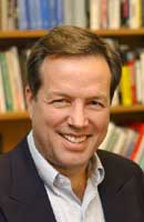 Dr. David W. Miller is the Executive Director of the Yale Center for Faith & Culture, an institute of Yale Divinity School, where he also serves as assistant professor of business ethics. Miller’s background is diverse. After graduating from Bucknell University in 1979, he went to work for IBM. Then he moved to England, where he served in senior positions in business and finance. (You can find a PDF of his resume here; or a prosaic bio here.)
Dr. David W. Miller is the Executive Director of the Yale Center for Faith & Culture, an institute of Yale Divinity School, where he also serves as assistant professor of business ethics. Miller’s background is diverse. After graduating from Bucknell University in 1979, he went to work for IBM. Then he moved to England, where he served in senior positions in business and finance. (You can find a PDF of his resume here; or a prosaic bio here.)
In 1995, Miller attended Princeton Theological Seminary, earning an M.Div. in 1998. He stayed on at Princeton Seminary, earning a Ph.D. in Social Ethics in 2003. His dissertation, The Faith at Work Movement: Its Growth, Dynamics, and Future, was the basis for his book, God at Work.
As you can see, David Miller brings together that which is rarely combined in one person: extensive business experience; theological education; church involvement (Miller is an ordained minister in the Presbyterian Church USA), and academic expertise.
About the Book
God at Work is based upon Miller’s Ph.D. dissertation. Upon hearing this, you might be inclined to regard God at Work as an overly academic and mostly unreadable tome. Though it is often true that published dissertations make for difficult reading, this is not the case for God at Work. This book makes for engaging reading. Much of the academic material has been put into 63 pages of footnotes and bibliography. The text of the book runs for only 153 pages.
The bulk of these pages focuses on the so-called “Faith at Work” movement, which Miller abbreviates as FAW. This movement emphasized the ministry of the laity, rather than clergy, and saw this ministry as happening in the world as well as the church. I had always thought of FAW as a post-World-War-II phenomena. But Miller shows that the roots of FAW grow deep into the social gospel movement that began in the late 19th century and continued into the middle of the 20th century.
The “first wave” of FAW, as Miller calls it, included themes that are still popular today. Among them would be “the popularization of Jesus” is such books as Charles Sheldon’s classic, In His Steps: What Would Jesus Do? The last few years have seen a resurgence of Sheldon’s emphasis on Jesus, especially in the emblematic abbreviation, WWJD?, which one can find on t-shirts, hats, and bumper stickers.
Miller identifies the “second wave” of FAW as “The Ministry of the Laity Era (c. 1946-1985)” (pp. 39-61). Miller identifies several early leaders of this era, including J.H. Oldman, Hendrik Kraemer, and Hans-Ruedi-Weber. They saw church renewal and impact as centered in the ministry of non-ordained people in the world.
I was especially interested in Miller’s mention of two people as leaders of the second FAW wave. One is Elton Trueblood, who argued that “The world is one, secular and sacred, and . . . the chief way to serve the Lord is in our daily work.” (p. 48). Trueblood, among other things, was the first speaker at Laity Lodge, where I now work. The other is Howard E. Butt, Jr., the founder of Laity Lodge. According to Miller, Butt combined “questions of personal salvation with social and economic justice in the workplace” (p. 55). His “promotion of lay ministry and ecumenism during wave two was, in light of his theologically evangelical roots, nothing short of ground breaking” (p. 55).
The second wave of the FAW movement ran out of gas, observes Miller, for a variety of reasons. In part, this happened when people began to see lay ministry “merely as a means to increase lay participation in the interior life of the gathered church, as opposed to equipping laity for the challenges of life in the scattered church” (p. 56). Miller adds that “clergy and church professionals often redirected the movement’s energy and purpose, redefining lay ministry as more active involvement in church committees and the internal life of the gathered church” (p. 59).
As a member of the clergy and as a former church professional, I’ll offer a mea culpa in response to this charge. It is terribly easy for those of us who are responsible for building and maintaining the church to value lay ministry only insofar as it contributes to this mission. But, in my experience, it’s not just clergy and church professionals who make this mistake. Church-focused lay ministers do it as well.
I’ll never forget a nominating committee meeting in my first year as Senior Pastor of Irvine Presbyterian Church. We were considering possible candidates for Deacon when somebody mentioned a man named Greg. Greg was rightly perceived to have great potential as a Deacon. But there was a problem. Greg was on the school board, in addition to running his own business and being a committed husband and father. His school board involvement took so much time that Greg couldn’t be a Deacon in the church. When this fact was brought up in the committee, a group of lay people, except for me, many were critical of Greg’s priorities. They devalued his work on the school board since it took away from his availability for church work. I was shocked. It seemed to me that Greg’s ministry on the school board was every bit as worthwhile as what he might be able to do in the church. In fact, I had recently met with Greg and talked about his school board involvement. He was there in service to Christ as well as to the community. Yet his peers, his fellow lay ministers, lacked Greg’s perspective and sense of broader calling, to my chagrin. In time, after lots of preaching, most folks in Irvine Presbyterian Church came to see ministry in the world as neither more or less valuable than ministry in the church. And, ironically, Greg sensed a different call in his life, and ended up serving as a Deacon in the church, a fine one, I might add.
Tomorrow I’ll continue my review of God at Work.
Note: For a related piece, see “FAITH: Christians Transformation Cultures” by AZDean. Also, see his comment below.
Topics: God at Work | 2 Comments »
You Know You’re Still in a Small Town When . . . .
By Mark D. Roberts | Monday, January 14, 2008
On Friday I put up a few highlights from the Boerne Star News police blotter. Here are a few more. Obviously Boenre has been having a crime wave recently.
December 15
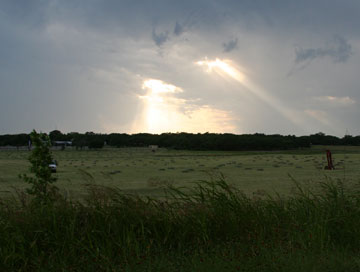 30100 block of Battle Intense, 3:37 p.m., A caller reported two men parked in a vehicle wearing black masks. As police headed to the location, they passed the vehicle and could see the men. The officer turned around and pulled over the vehicle. The men said they had been fishing. The officer observed fishing equipment in the vehicle and when license checks showed that neither man was wanted, the men were released. [MDR: Hey, officer, they were just trying to disguise themselves to the fish wouldn’t recognize them. And what about the name of that street: “Battle Intense.” I understand it’s the name of a famous bull. Only in Texas . . . . Photo: a field in Boerne, about a mile from our house]
30100 block of Battle Intense, 3:37 p.m., A caller reported two men parked in a vehicle wearing black masks. As police headed to the location, they passed the vehicle and could see the men. The officer turned around and pulled over the vehicle. The men said they had been fishing. The officer observed fishing equipment in the vehicle and when license checks showed that neither man was wanted, the men were released. [MDR: Hey, officer, they were just trying to disguise themselves to the fish wouldn’t recognize them. And what about the name of that street: “Battle Intense.” I understand it’s the name of a famous bull. Only in Texas . . . . Photo: a field in Boerne, about a mile from our house]
Dec. 16
100 block of W. Blanco Road, 8:52 a.m., A maintenance worker reported burnt paper and dirty clothes were left in a men’ restroom and nachos were found in an elevator. No permanent damage was reported. [MDR: That’s good news, because, when left unattended, nachos can do lots of damage.]
Dec. 31
100 block of Glenn Oaks Drive, 8:52 a.m., A resident reported that a neighbor cut down part of the caller’s tree to put up a basketball hoop and put the branches in the caller’s yard. [MDR: Okay, it’s bad enough to cut down part of a neighbor’s tree without asking. But then putting the branches in the neighbor’s yard? C’mon!]
Jan. 1
7900 Fair Oaks Parkway, 2:19 a.m., While on patrol, an officer found a truck in a parking lot. The officer stopped to check the vehicle and found two teenagers in the back seat in various states of undress. After police spoke with both, the boy was released and the girl called an adult friend of the family who picked her up. [MDR: Moral of the story = Nothing good happens in the back seat of a truck after 2:00 in the morning. Nothing.
Jan. 2
700 block of River Mountain Drive, 2:41 p.m., A man reported the burglary of a shed. [MDR: Wow! It’s hard to walk off with a whole shed.]
Jan. 3
100 block of Old San Antonio Road, 7:07 a.m., A man reported the burglary of a building. [MDR: It’s getting worse. Now people are stealing entire buildings!]
100 block of S. Main Street, 11:34 a.m., A downtown shop owner reported a possible burglary after finding a display case damaged. Police found no signs of forced entry and nothing was missing. The damage was apparently caused by an animal falling through the ceiling. Officers requested a trap be placed at the shop. [MDR: Those Boerne police officers are so demanding.]
MDR: Yup. We live in a small town now.
Topics: Small Town, Police Blotter | 3 Comments »
Only in Texas: Po-Po Family Restaurant
By Mark D. Roberts | Saturday, January 12, 2008
In the Texas Hill Country about 30 miles northwest of San Antonio you’ll find a Texas original: Po-Po Family Restaurant. Here you can find authentic Texas cuisine, wonderfully prepared. The restaurant was named by a former owner who had made several trips to Mexico and was impressed by Popocatepetl, the famous Mexican volcano. 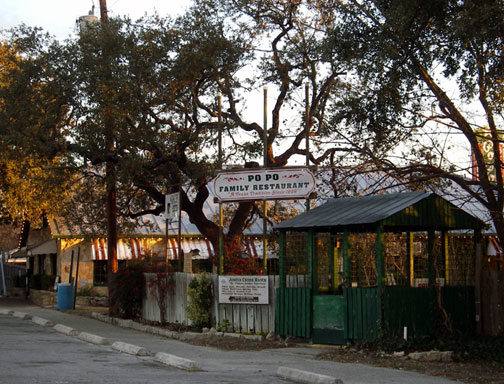
Part of the fun of “Po-Po’s,” as the locals call it (and we qualify as locals in that we live only about five miles away), is the collection of plates adorning the restaurant walls. There are about 2000 plates in all, covering virtually every square inch of wall space.

If you’re ever in the Hill Country, be sure to check out Po-Po’s.
Topics: Only in Texas | 3 Comments »
You Know You’re in a Small Town When . . . .
By Mark D. Roberts | Friday, January 11, 2008
As most of my reader know, I recently moved from Irvine, California (population about 200,000) to Boerne, Texas, (population about 9,000). Irvine is part of Orange County (population about 3,000,000). Boerne is in Kendall County (population about 30,000). As you can imagine, there have been some changes in my lifestyle since moving to a small town.
One change has to do with crime. We do have crime in Boerne. In the first six years of this decade there were one murder and twelve robberies in the town. Not much crime, mind you. Irvine, California prides itself on being one of the safest cities in the country. But the police blotter in the Irvine paper was not nearly as interesting to read as the police blotter in the Boerne Star, our local newspaper. Mostly we have problems with intoxication around here. But some of our crime is more unusual. I’d like to share some recent excerpts from the Boerne Star. Note: I have not changed a word.
Public Records as found in the Boerne Star, December 2007
Dec. 7
 200 block of E. Hosack, 12:55 p.m., A resident reported a woman in her back yard burning leaves and wanted the woman removed. Police found a woman cooking a hot dog in a barbeque pit. The woman left without incident. [MDR: Don’t you hate it when somebody is cooking a hot dog in your back hard without asking. No mention of whether she got to eat the hot dog or not.] (Photo: people walking on Main Street in Boerne. No crime, though, because the street was blocked for the annual Christmas parade.)
200 block of E. Hosack, 12:55 p.m., A resident reported a woman in her back yard burning leaves and wanted the woman removed. Police found a woman cooking a hot dog in a barbeque pit. The woman left without incident. [MDR: Don’t you hate it when somebody is cooking a hot dog in your back hard without asking. No mention of whether she got to eat the hot dog or not.] (Photo: people walking on Main Street in Boerne. No crime, though, because the street was blocked for the annual Christmas parade.)
600 block of S. Plant Street, 5:05 p.m., A woman called police about a black sports car in the area and strangers coming out a of neighbor’s house and waving at her. [MDR: I hate it when strangers are friendly.]
Dec. 9
100 block of Aransas Pass, 2:52 a.m., A resident called police after hearing someone jiggling the knob on the front door very hard. Police contacted a neighbor who said a friend was staying with him because she was drunk and that she had gone to the wrong door by mistake. [MDR: Oops.]
Dec. 10
100 block of Stone Creek Circle, 11:23 a.m., A man came to the police department to report the theft of mail a year ago. [MDR: Talk about procrastination!]
Dec. 14
526 mile marker Interstate 10, Comfort, 3:57 a.m., A man was arrested for driving while intoxicated after being pulled over for driving in the middle of the highway at 5 mph. [Note: If you don’t want to be found out, don’t drive in the middle of the Interstate going 5 mph. It’s a dead giveaway.]
Dec. 15
1300 block of S. Main. St., 11:08 a.m., Police were called to Wal-Mart after one of the store’s assistant managers reported that someone had driven a car around to the loading dock, jumped out of the vehicle leaving it running and got into another car and left. About 5 minutes later, a customer called to report her car was missing. The woman identified the car parked at the loading dock as the rental car she had parked in the lot and left the keys in the ignition. The assistant manager described the second car the man had gotten into and officers located it in the parking lot. While police waited for someone to return to that car, officers observed a man, who was wanted for an outstanding municipal warrant, walking through the parking lot. He was arrested on that warrant for speeding, which was not related to the first car. Another man later returned to the second car and admitted taking the first car to “teach the woman a lesson.” The woman did not want to press charges, and the man was released with a warning. [MDR: Note to self - Don’t steal car to teach someone a lesson.]
Topics: Small Town, Police Blotter | 6 Comments »
Give Back to Bethlehem.org
By Mark D. Roberts | Thursday, January 10, 2008
 I’ve recently become aware of a business venture that seems, as far as I can tell, to be working towards peace between Israel and Palestine in a creative way. God knows we need some new approaches over there. The goal of Give Back to Bethlehem.org is to sell apparel made in a Bethlehem factory. It seems to represent an usual cooperative effort among diverse and often divided peoples. Give Back to Bethlehem.org is part of No Sweat apparel, which is a for-profit company. (Photo: a Christian fish-emblem t-shirt made by Palestinians in Bethlehem and sold by an American company owned by a Jewish couple. Now that’s something!)
I’ve recently become aware of a business venture that seems, as far as I can tell, to be working towards peace between Israel and Palestine in a creative way. God knows we need some new approaches over there. The goal of Give Back to Bethlehem.org is to sell apparel made in a Bethlehem factory. It seems to represent an usual cooperative effort among diverse and often divided peoples. Give Back to Bethlehem.org is part of No Sweat apparel, which is a for-profit company. (Photo: a Christian fish-emblem t-shirt made by Palestinians in Bethlehem and sold by an American company owned by a Jewish couple. Now that’s something!)
Here’s a video from Al Jazeera that reports on this operation.
And here are some published stories about this business:
From Sojourners Magazine
From Haaretz
From the Boston Globe
I’m interested in your thoughts about this effort. Leave a comment if you wish. Thanks.
Topics: Recommendations | 1 Comment »
Letting Go and Coming Back
By Mark D. Roberts | Wednesday, January 9, 2008
Part 5 of series: Letting Go of a Church
Permalink for this post / Permalink for this series
When pastors leave a church, they need to let go. This is essential for the health of the church, both in the present and the future. When pastors who leave continue to assert their influence, almost inevitably future pastors are undermined. Love and friendship continue, but pastoral leadership comes to end.
At least for the most part. If a pastor has let go of a congregation, there is a time when involvement, even pastoral activity to some extent, can be appropriate. For example, a friend of mine is the senior pastor in a Presbyterian church. A former senior pastor of that church is actively involved in the congregation in a way that is consistently helpful. Why does this work so well? For one thing, the former pastor is not my friend’s immediate predecessor. One installed and two interim pastors stand between them, as well as about ten years. Furthermore, the former pastor is a staunch supporter of my friend’s leadership. If he has any misgivings, he keeps them to himself. Period.
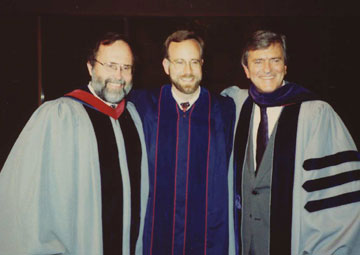 A second example comes from my own experience at Irvine Presbyterian church. I was the second installed pastor of the church. Ben Patterson, now the campus pastor of Westmont College, was the founding pastor of the church. When he left the church after fourteen years, there was an eighteen-month interim period before I came as the new pastor. At my invitation, Ben preached at my installation service, offering enthusiastic support for my leadership. Ben continued to preach at the church about once a year for many years, and I’d have been happy to have him more often. One of my all-time favorite memories of my ministry at Irvine Pres was our 25th anniversary worship service when both Ben and I preached and then we shared in serving communion together. Ben was always one of my strongest supporters, and his support aided my leadership and encouraged me personally. If Ben ever thought I made a poor decision – and I expect he must have done so because I made plenty of them – he never let me know and never said anything about this to anyone who might influence the church. (Photo: my installation service in 1991, with Ben Patterson [left] and Lloyd Ogilvie [right]).
A second example comes from my own experience at Irvine Presbyterian church. I was the second installed pastor of the church. Ben Patterson, now the campus pastor of Westmont College, was the founding pastor of the church. When he left the church after fourteen years, there was an eighteen-month interim period before I came as the new pastor. At my invitation, Ben preached at my installation service, offering enthusiastic support for my leadership. Ben continued to preach at the church about once a year for many years, and I’d have been happy to have him more often. One of my all-time favorite memories of my ministry at Irvine Pres was our 25th anniversary worship service when both Ben and I preached and then we shared in serving communion together. Ben was always one of my strongest supporters, and his support aided my leadership and encouraged me personally. If Ben ever thought I made a poor decision – and I expect he must have done so because I made plenty of them – he never let me know and never said anything about this to anyone who might influence the church. (Photo: my installation service in 1991, with Ben Patterson [left] and Lloyd Ogilvie [right]).
In both of the cases I’ve mentioned, the pastor who truly lets go of a church is able to receive it back, even in some sense in a pastoral relationship. The two essential elements in this process are:
Time: It takes time for a church and a former pastor to let go of each other enough so that they might receive each other back in a new and healthy way.
The behavior of the former pastor: If the former pastor supports the new pastor and church leadership consistently, then a new, edifying relationship between church and pastor is possible.
This second factor raises the question of what former pastors should do if they don’t truly support the actions of new pastors and leaders. In my opinion, the pastors should almost always keep their concerns to themselves. The only exception I can imagine is if a church were actually abandoning essential theology. But, even then, the former pastor might choose to keep quiet and let authorized church officials deal with the theological aberration.
Unfortunately, many pastors mess around with their former churches, openly and/or covertly undermining new leaders. The result is a painful mess, and usually leads to the weakening of the church that the former pastor pledges to love. These days, it’s increasingly common today for former pastors to open up shop right down the street from their previous congregations and start a new church. The net result is rarely a positive one for the churches involved, not to mention the kingdom of God.
As one who is in the middle of letting go of my former church, I can understand the temptation to stay too involved. But, in the end, I truly want Irvine Presbyterian Church to be everything Christ wills it to be. This will happen, I believe, as he guides the current and future leaders of the church . . . without my involvement. My chief task at this point is to take my love for this church and turn it into heartfelt prayer, trusting Christ to be Lord of his church. In the classic phrase, my job now is to “Let Go and Let God.” By his grace, I’ll be able to do so more and more.
Topics: Pastors and Churches | 1 Comment »
What is Helping Me to Let Go (Section C)
By Mark D. Roberts | Tuesday, January 8, 2008
Part 4 of series: Letting Go of a Church
Permalink for this post / Permalink for this series
So far I’ve mentioned seven factors that are helping me let go as pastor of Irvine Presbyterian Church. They are:
1. My Conviction that the Church and I Need to Move On
2. My Observations of What Happens When a Pastor is Too Involved with a Former Church
3. My Personal Support System
4. Physical Distance Between the Church and Me
5. I Love My New Job and Have Plenty to Do
6. A “Boundaries Covenant” Between Irvine Presbyterian Church, Los Ranchos Presbytery, and Me
7. My Advance Communication to the Members of Irvine Presbyterian Church
Today I’ll finish up this list with three other factors.
8. My Confidence in the Leadership of Irvine Presbyterian Church
Most of the authority in a Presbyterian church is given to the Session, the board of elders and pastors. The pastor has specific and unique authority only over the content of the worship service/preaching. Otherwise, authority resides in the Session.
Irvine Presbyterian Church has always had outstanding Session leadership, and this is just as true today as it was when I was pastor. If anything, I can envision new pastoral leadership contributing to the growth and strength of the Session. My confidence in the current leadership of the church certainly makes it easier for me to let go.
Since I’ve been gone, the leaders have made a few changes, some of which have touched things I put into place when I was pastor. Though I would confess to moments of wistfulness about a couple of these, I fully support the actions of the Session. I know their integrity, their wisdom, their prayerfulness, and their heartfelt desire to honor God in all they do. Thus I believe they are doing what’s best for Irvine Pres. Plus, I’m well aware that churches need to change, and that a pastor’s departure usually allows for necessary change that the former pastor just couldn’t lead.
9. My Confidence in the Interim Pastor of Irvine Pres
In most cases, when a senior pastor (which Presbyterians simply call “pastor”) leaves a church, an interim pastor leads the church for a year or two. In my experience, most interim pastors are older, experienced pastors who aren’t yet ready to retire, though some people are called to interim pastoring when they are younger. They bring lots of wisdom to their interim task, which they understand as helping the church get ready for fruitful ministry under a new senior pastor.
I didn’t know the interim pastor of Irvine Pres until a few months ago. But I have come to have the highest regard for Pastor Rick Hull and his leadership. This began when he interviewed me by phone prior to his accepting the call to come to Irvine. I quickly sensed his passion for Christ, his love for the church, and his excellence in leadership. My high regard for Pastor Rick grew as we got to know each other personally. And my confidence in his leadership has grown further during the past few months as, from a distance, I have watched him lead the church by his preaching, pastoral care, and administrative efforts. I am grateful to have passed on my pastoral torch into such competent hands.
I realize that not all churches go the interim pastor route. And I’m sure there are times when an immediate change from one installed pastor to another works well. But I am an energetic proponent of interim pastoring because I have seen it work well in so many cases, including my own. Irvine Presbyterian Church was founded by Ben Patterson, a man of distinctive strength and charisma. I’m not sure the church would have been ready to accept me as its pastor were it not for the interim leadership of Pastor Jim Hewett.
10. A Reminder of Whose Church is Irvine Presbyterian Church
In one sense, the church to which we belong is “our church.” Similarly, the church where a pastor serves is that pastor’s church. For sixteen years and three months Irvine Presbyterian Church was “my church.”
But it’s terribly easy for pastors (and prominent lay leaders as well) to say “my church” with a meaning that isn’t right. We can begin to feel ownership for a church that goes beyond appropriate stewardship. We can see “my church” as that which I control, even as that which contributes to my own glory. When this happens, both pastors and churches are in grave danger.
Irvine Presbyterian Church was never my church in the sense of ownership. It always belonged to Jesus Christ, and to him alone. All Presbyterians should acknowledge because the first section of the Presbyterian Book of Order makes this abundantly clear:
G-1.0100 1. The Head of the Church
Christ Is Head of the Church
a. All power in heaven and earth is given to Jesus Christ by Almighty God, who raised Christ from the dead and set him above all rule and authority, all power and dominion, and every name that is named, not only in this age but also in that which is to come. God has put all things under the Lordship of Jesus Christ and has made Christ Head of the Church, which is his body.
Christ Calls the Church Into Being
b. Christ calls the Church into being, giving it all that is necessary for its mission to the world, for its building up, and for its service to God. Christ is present with the Church in both Spirit and Word. It belongs to Christ alone to rule, to teach, to call, and to use the Church as he wills, exercising his authority by the ministry of women and men for the establishment and extension of his Kingdom.
Christ Gives the Church Its Faith and Life
c. Christ gives to his Church its faith and life, its unity and mission, its officers and ordinances. Insofar as Christ’s will for the Church is set forth in Scripture, it is to be obeyed. In the worship and service of God and the government of the church, matters are to be ordered according to the Word by reason and sound judgment, under the guidance of the Holy Spirit.
Christ Is the Church’s Authority
d. In affirming with the earliest Christians that Jesus is Lord, the Church confesses that he is its hope and that the Church, as Christ’s body, is bound to his authority and thus free to live in the lively, joyous reality of the grace of God.
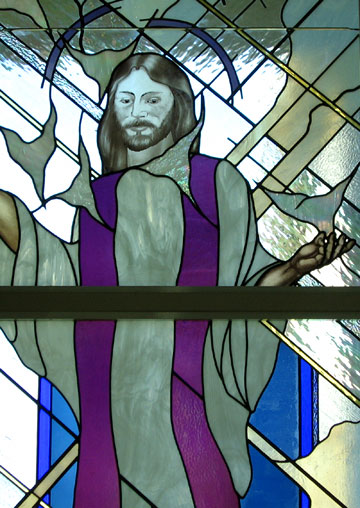 During my tenure as pastor of Irvine Presbyterian Church, I was mostly aware that Christ “owned” the church and I was simply his servant and steward. Surely there were times when I held the church too tightly, but inevitably the Lord helped me to loosen my grip. (Photo: from a stained glass window in the sanctuary of Irvine Pres)
During my tenure as pastor of Irvine Presbyterian Church, I was mostly aware that Christ “owned” the church and I was simply his servant and steward. Surely there were times when I held the church too tightly, but inevitably the Lord helped me to loosen my grip. (Photo: from a stained glass window in the sanctuary of Irvine Pres)
Leaving my pastoral position at Irvine Pres has, more than anything else, forced me to remember whose church it is. It isn’t mine. Never was. In fact, Irvine Presbyterian Church doesn’t belong to the staff, or the elders, or the congregation, or the presbytery, or the Presbyterian Church USA. It belongs truly and solely to Jesus Christ. What’s true of the whole church is true of Irvine Presbyterian Church in particular: “It belongs to Christ alone to rule, to teach, to call, and to use the Church as he wills” (G-1.0100b).
In the end, I will be able to let go of Irvine Presbyterian Church because I acknowledge that it is now, as it always has been, in the hands of Christ. My concerns for the church and my love for its people will lead me to pray, acknowledging that Christ alone is head of this church, and that his will alone is what should be done. Thus letting go is, for me, ultimately a matter of trusting God more. It’s an occasion for me to grow in my faith as I let God be God.
Topics: Pastors and Churches | 5 Comments »
What is Helping Me to Let Go (Section B)
By Mark D. Roberts | Monday, January 7, 2008
Part 3 of series: Letting Go of a Church
Permalink for this post / Permalink for this series
On Friday I mentioned five things that are helping me let go as pastor of Irvine Presbyterian Church. They were:
1. My Conviction that the Church and I Need to Move On
2. My Observations of What Happens When a Pastor is Too Involved with a Former Church
3. My Personal Support System
4. Physical Distance Between the Church and Me
5. I Love My New Job and Have Plenty to Do
Today I’ll add two more to the list.
6. A “Boundaries Covenant” Between Irvine Presbyterian Church, Los Ranchos Presbytery, and Me
If you’re not a Presbyterian, let me say that a presbytery is an organization of Presbyterian churches in a given location that helps its churches thrive in their ministries. The presbytery exercises some authority over its member churches. Irvine Presbyterian Church is part of Los Ranchos Presbytery, which includes Orange County and a part of Los Angeles County in Southern California. In most matters, the church has authority over its own life. But in matters having to do with pastors, the Presbytery offers guidance and accountability. When I left Irvine Presbyterian Church, I signed a “Boundaries Covenant”, which was also signed by leaders of the church and the presbytery. Here is the essence of this covenant:
Both Pastor & Session (on behalf of the church) mutually agree to support the following conditions of the covenant:
1. As of the above date, the pastor will relinquish all pastoral and administrative duties and will no longer function as part of the pastoral or administrative team of the church.
2. The pastor is determined to be supportive of future pastoral and lay leadership of the church and will refuse to receive or participate in any negative comments, conversations or activities which might undermine any program or person of the church.
3. Any future contacts which may occur between the pastor and the congregation will be as friends and not in a pastor/parishioner relationship. The pastor will not participate in any weddings, funerals, baptisms, nor engage in any hospital or pastoral visitation or serving of Holy Communion unless requested by the Session (which includes the Moderator/installed Pastor/Head of Staff). This is intended to allow the new pastoral relationship to develop. [Exceptions to this provision must be agreed to prior to signing this Covenant and attached as an Appendix.]
Notice that the “Boundaries Covenant” does allow for exceptions, In fact, I was permitted to perform a wedding for a church family after I left the church. It was something to which I had committed long before I was called away from the church and which was judged not to compromise the well-being of the church.
7. My Advance Communication to the Members of Irvine Presbyterian Church
After I announced that I would be leaving Irvine Pres, I preached several sermons that were intended to help church members prepare for the future. In one of these sermons, I preached on 1 Corinthians 3:5-11. This text talks about how Christians are to think of their leaders, emphasizing that human leaders are mere servants, and that God is the one who really matters. (Photo below: A preacher’s view of Irvine Presbyterian Church)

In the context of this message, I spoke specifically about how my relationship with the church would need to change. I asked people, for example, not to tell me about changes in the church they didn’t like. I asked them to respect my need to step back from my pastoral role. I urged them to support their future leaders, including their next installed pastor. These statements not only helped church members get ready for the future. They also built in accountability for me. If I were to meddle in church business in the future, my own members would be prepared to tell me to knock it off.
I also preached several sermons that pointed to the future. I wanted my congregation to focus less on me and my leaving and more on God’s future for the church. That future, I said, is wonderful. Irvine Presbyterian Church is headed for better days, days of greater fruitfulness in ministry, greater outreach to the community, and deeper growth in fellowship and in Christ. I really believe this, and feel a little like Moses on the edge of the Promised Land. I can see great things ahead for Irvine Presbyterian Church, but will not be the pastor to lead that church into those great things. I am praying, even now, for the pastor who will be called to Irvine Pres in a year or two. What a wonderful, challenging, hopeful calling it will be!
Tomorrow I’ll mention a few more things that are helping me let go of Irvine Presbyterian Church.
Topics: Pastors and Churches | 1 Comment »
Sunday Inspiration from The High Calling
By Mark D. Roberts | Sunday, January 6, 2008
Be Fruitful and Multiply
“Then God blessed them and said, ‘Be fruitful and multiply. Fill the earth and govern it. Reign over the fish in the sea, the birds in the sky, and all the animals that scurry along the ground.’ ”
Why are we here on earth? For centuries, philosophers and theologians have debated this question. No doubt the debate will continue for centuries to come. The first answer we find in Scripture might surprise us. God created human beings in his image so that we might “be fruitful and multiply” and “fill the earth and govern it.” On a literal level, being fruitful and multiplying has to do with procreation. Yet, beyond this, we see that God intends for us to contribute to this world, to add to his creation. Moreover, we are to take care of it, to manage that over which God remains the true owner.
How fruitful is your life? Are you making a difference in the world? And how are you doing with managing that part of God’s creation entrusted to you?
PRAYER: Thank you, dear Lord, for creating us with a purpose, with something to do in this world. By your grace, help us to live fruitful lives, to contribute to this world in a meaningful way. May we see each moment of each day as a chance to fulfill your fundamental calling to us. Furthermore, give us the wisdom to manage well that part of the world you have given to us: our work, our family, our neighborhood, our church. May we glorify you in all we do. Amen.
A picture of fruitfulness . . .

For my Daily Reflections during the week, visit The High Calling of Our Daily Work. At this website you can also sign up to have the Daily Reflections sent to you by e-mail.
Topics: Sunday Inspiration | No Comments »
Final Christmas Photos
By Mark D. Roberts | Saturday, January 5, 2008
From the family worship service on Christmas Eve at the First Presbyterian Church of Hollywood. Angels we have heard on high . . . .
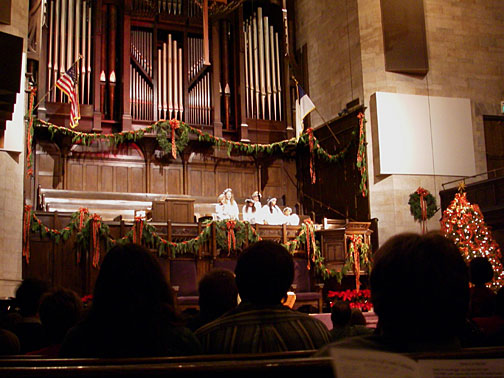
From Balboa Island near Newport Beach, California. Now those are some Christmas lights, don’t you think? This is my photo. For more photos and video clips of this amazing house, check out http://www.zimchristmas.com/.

Topics: Christmas | No Comments »





